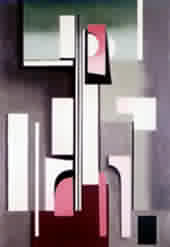
Composition #242, 1937
Born in 1890, Jean Xceron (Xerocostas) emigrated from Greece in 1904, the first of this group of Greek American artists-to-be to come to the United States. He had been painting portraits of Greek revolutionary heroes on the walls of his father's house in Isari in the Peloponnesus, and now, after arriving in the United States at the age of fourteen, he turned to making icons for the families he lived with in Pittsburgh, Indianapolis, and Washington, D.C. Like most immigrants, the teenage Xceron had to work hard in his relatives' businesses-hat-cleaning and candy stores, shoeshine and ice cream parlors-and he kept trying to persuade them to send him to art school. In 1918 he enrolled in the Corcoran School of Art in Washington, D.C., and began copying plaster casts in the time-honored tradition of art instruction. For Greek Independence Day in 1918, he painted a huge temporary mural for the Treasury Building in Washington, D.C., portraying Greek gods and heroes together with the heroes of the Greek Revolution. He even considered earning a living as an icon painter.
Instead, Xceron moved to New York to follow the avant-garde more easily. Here, he met and became friendly with Uruguayan painter Joaquin Torres-Garcia, who urged him to liberate himself from the "baggage" of the past "in order to live in the abstract." In 1927 Xceron moved to Paris, where he lived until the late 1930s, working as a critic, and through friendships with the avant-garde he learned much that his art studies had not taught him. In 1931 he had his first solo exhibition, at the Galerie de France, and the Paris art world discovered a fine new painter of geometric abstraction.
In 1938, Xceron read the signs of impending war like many other European artists and intellectuals and moved permanently with his wife to New York. In 1939, he took a job as a guard at the Guggenheim Museum, which already housed many of his best works. Hilla Rebay, whose Museum of Non-Objective Painting formed the basis of the Guggenheim's collection, considered Xceron to be one of America's most important abstract painters; he once proposed to remodel the fountain ac the bottom of the museum's spiral ramp, covering it with a colorful tile mosaic of his own design, although the project was never carried out. Arising from his refined sensibility, Xceron's work is characterized by syncopated rhythms and a rigorous geometry. He continued to work as a guard at the museum and to exhibit his work regularly until his death in 1967.